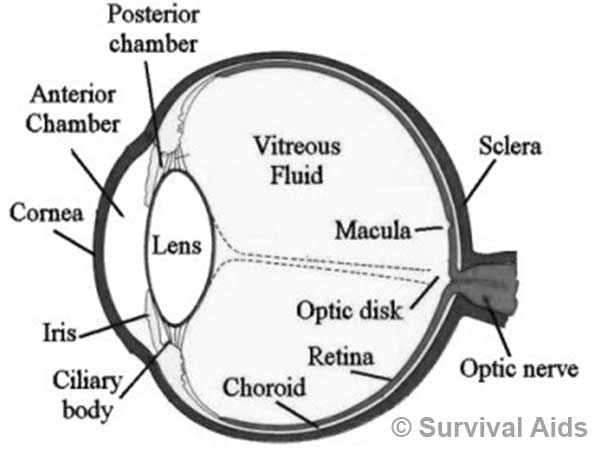The Skills And Disciplines For Field Craft
When we talk about “fieldcraft” we refer to the military skills you are required to master to be an effective soldier. They are required in order to operate by day or night and in all weathers “to see without being seen, and to find and destroy the enemy”.
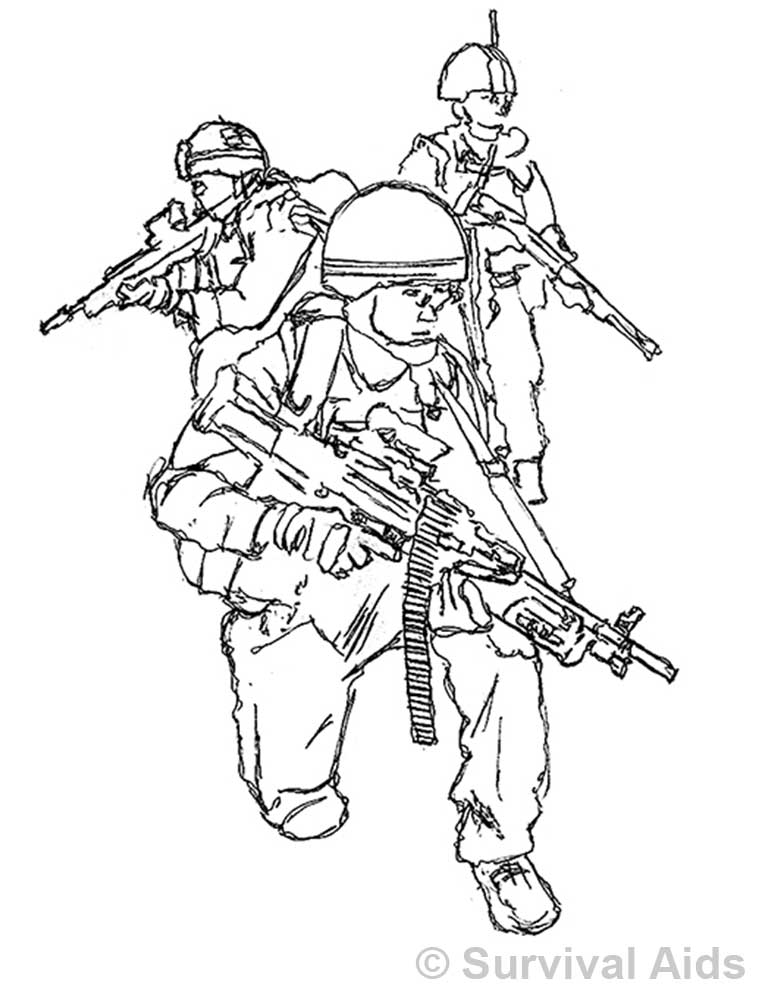
These skills, which are all disciplines in their own right, are covered during your basic training, but as with any skill, in order to prevent skill fade, they need to be practised regularly. So keep the Soldiers Pocket Book on you, and refer to it when you need it. Better still practice, practice, practice so that when you need it, you can do it, and with practice will come natural ability and respect from your colleagues, “He’s a switched on bloke” is better than “that muppet”.
So you could say, that everything in this book comes under the heading of “fieldcraft”.map reading and navigation, camouflage and concealment, judging distances, fire control orders, understanding the difference between cover from view and cover from fire, using the terrain and its features to mask ground movement, obstacle crossing, selecting good fire positions, lying up positions, effective observation, penetrating the enemy’s camouflage.
The scope of this section is individual skills and patrol/section level. The operational environment is constantly changing, enemy forces can now observe our tactics freely and in the open and as a consequence they are constantly changing their methods of attack, sometimes literally street by street, he is committed, resourceful and cunning. Never before in history have we had to be so adaptable.
Equipment, vehicles, radios and TTPs are changing as the threat changes. We are better equipped now than we have ever been to. UOR (Urgent Operational Requirement) has bought in new weapons like the Sharpshooter Rifle (pictured) along with new body Armour and vehicles. We are all required to be fit, robust and technically proficient, but we must not forget the basics. The basics that we will cover in this book, are the foundations on which innovative new equipment and techniques sit.
BE FIT, PREPARED AND READY
Regardless of your cap badge you are a soldier first, you will be sent where you’re needed and you may find yourself in close proximity to the enemy, getting the rounds down. You will need to be able to give a sitrep over the net, to give first aid, to be fit enough to drag a wounded comrade into cover. So use your spare time wisely, relearn things you’re a bit rusty on, don’t wait until your under contact to practice fire control orders.
ORGANISATION OF THE INFANTRY BATTALION (BN)
Below, is a diagram of a typical infantry battalion of approx. 650 men, in the light role. Within the Bn, which is commanded by a Lt Col, there are 3 rifle companies (Coy) commanded by Majors in the Bn, and 3 rifle platoons (Pl) commanded by lieutenants in a rifle coy, the Pl is further split into 3 Sections. We are going to concern ourselves with platoon and section skills and tactics in this book.
A simple way to remember the layout of a Bn is, there are
3 sections in a platoon, there are
3 platoons in a company, there are
3 companies in a Bn and there are
3 Bns in a Regt.
3 sections in a Pl, 3 Pl in a Coy, 3 Coy in a Bn, 3 Bns in a Regt.
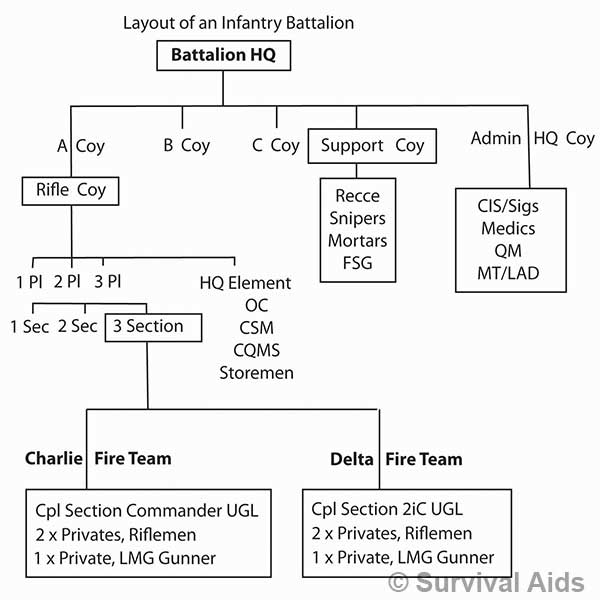
We have included a layout diagram of an Armoured Inf. Bn, which follows and is very similar to the light role, each Pl. will be housed in 4 warrior AFV with each section in one warrior, which will transport it to its dropping off point, provide it with cover and protection.
RIFLE CO SECTION
The section is made of 8 men, and is the smallest unit within the Bn, it is usually led by a Cpl who takes command of Charlie Fireteam, and supported by his 2iC, a L/Cpl who commands delta fire team. A depleted section can operate with five riflemen and one NCO.
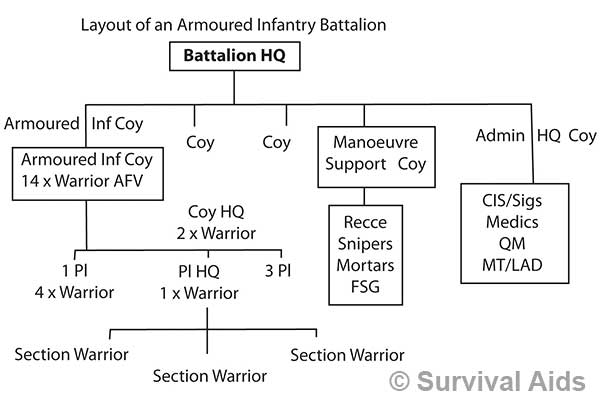
SECTION 2IC
As well as being the next in command of the section, the 2ic will also report into the Pl Sgt regularly with ammo/cas states, so that the Pl Sgt can resupply the section with enough ammo for the next objective
Charlie and Delta Fire teams provide each other mutual support and are mirror images of each other, each containing an NCO and 3 riflemen, the section commander and 2ic will be armed with SA80 UGL and each fireteam will have a Minimi man and often a sharpshooter. The section will also carry NLAW or the new LASM.
The advantage of subdividing the section into two groups C + D is that you have readily deployable teams, that know each other and work together, that can form patrols, op parties etc...
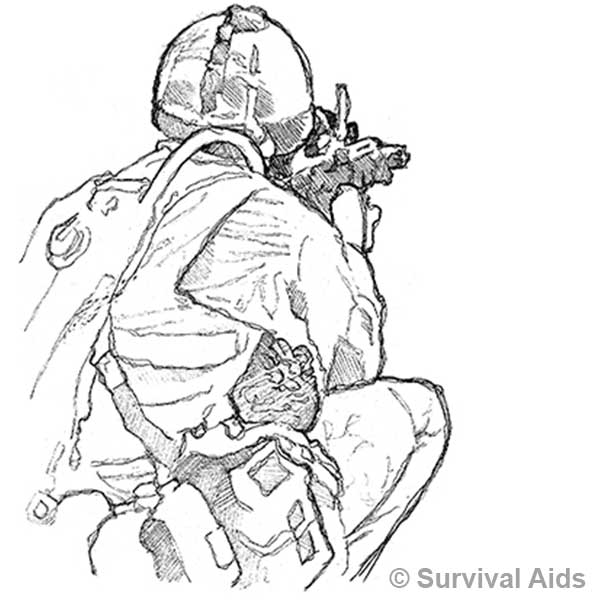
BREAKING UP THE GROUND
Before a section moves out, the section commander will make an appraisal of the ground ahead, the next bound. Moving ahead he will identify his axis of advance and then break the ground down into identifiable chunks, near the ground, middle and distant, as well as identifying obvious features which he will name. These will be referred to if and when needs to get his men into cover.
Choosing a route is much easier than it was years ago; maps, aerial photos, satellite imagery and previous patrol reports can all be accessed at the click of a mouse, not to mention the real-time eye in the sky. But you must still possess the skills and clarity of mind to interpret the information you have and choose the safest course for you and your men, in order to achieve the mission.
Break it down into legs/stages, so that if you get lost or disorientated you can backtrack to the end of the last leg, then get back on course, check and re-check your navigation often and get a switched on a member of the section to do check navigation, just in case.
Learn to trust in your compass, as your experience grows, you will learn to let the compass do its work, and trust in your skills, keep in cover a much as you can, learn to use the terrain to your advantage, to see without being seen.
However, if you have to expose yourself to view, it’s better to do it earlier in the route when you are a distance from the enemy than to risk detection when you are close to his weapons.
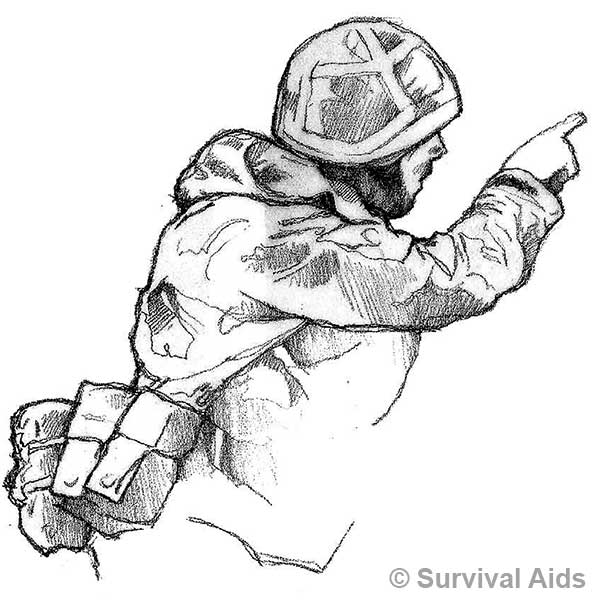
When doing your map study imagine where you would put your ambush if you were the enemy, chances are that’s where he’ll put his. Look for good fire positions and cover from view along the way, try and avoid obstacles like marshes, wide-open ground and ravines if you can. Negotiating these will mean you’re static and exposed for long periods, and that’s dangerous. The best routes will have cover from both view and fire, as well as being within sight of some form of friendly fire support, be that from an SF crew on high ground, or from a nearby FOB.
However, you’ll rarely get it all, so you need to adapt, be creative, brave and make the best of what you’ve got.
CHANGE YOUR POSITION REGULARLY
When you get into a good firing position, don’t get complacent. After a few shots the enemy may well see you from the dust and debris kicked up by your muzzle, and he might get himself into a position waiting for you to reappear. Keep him guessing, keep moving. Make each round count, there’s a time for getting a burst off, if you’re confronted with the enemy in front of you need to ensure his head down while you dart for cover. The rest of the time it’s aimed shots, from good fire positions.
SECTION FORMATIONS
Crossing different types of terrain, the section will adopt different formations in order to cross the ground in a way that will allow it to best achieve the mission or to bring its weapons systems to bear on the enemy.
The formation adopted will depend on the terrain being negotiated, the likely direction of the enemy, visibility and if you have air cover.
Single file: moving along linear features, easy to control, especially at night and when nominating RVs, but might make an easy target for an enemy to your front, a burst of automatic fire might down much of the section. Difficult to bring the sections weapons to bear quickly to the front.

File: like single file it’s easy to control at night, patrolling along with a linear feature, half the section on each side of the feature.

Arrowhead: useful when moving across open ground, toward the enemy, as weapons can be bought to bear quickly. Commander can position himself in the middle or slightly to the rear.
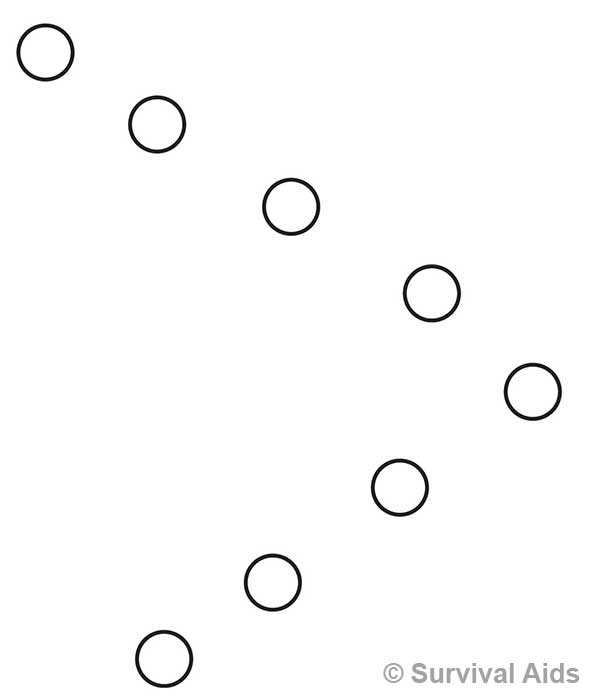
Extended Line: in the assault or from a start line, as a commander, it’s more difficult to control as your men are further away from you.
Points to note: always look into your commander for signals and instructions, if you’re out of comms. or your radio goes dead, keep your eye on bloke left or right of you, think for yourself and anticipation at all levels. Don’t get target fixated. Change batteries in your PRR as soon as possible, have spare batteries to hand. Stay in formation, it’ll make the bosses job a lot simpler.
HAND SIGNALS
Hand Signals allow silent communication, they are particularly useful at night, they will vary from unit to unit, each will have their common ones, make sure before you deploy on an exercise or an operation that you do a dry rehearsal (daylight, noisy) so that everyone is familiar with them, then do a nighttime rehearsal
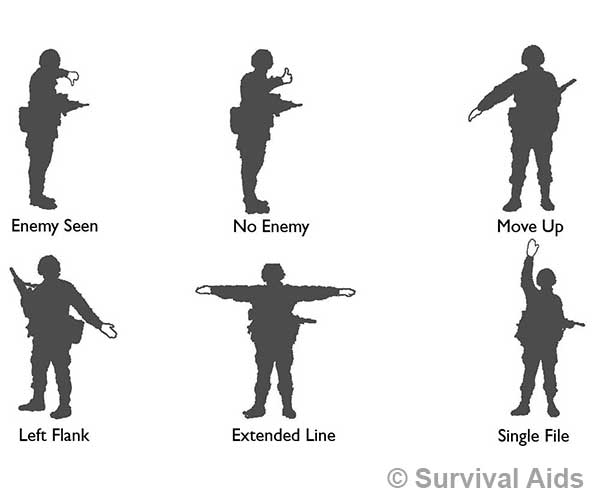
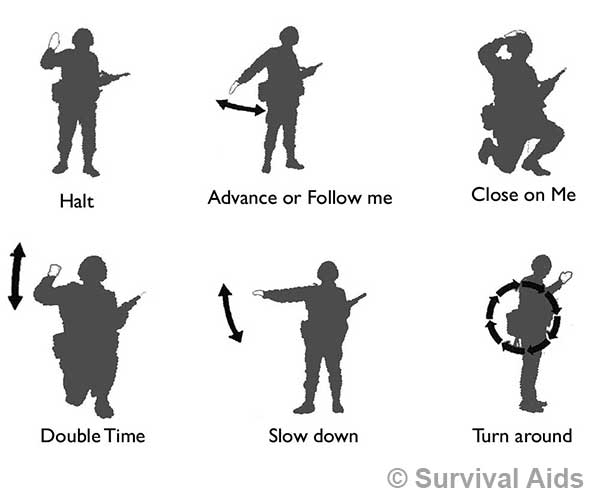
CAMOUFLAGE AND CONCEALMENT
So why are things seen? What makes you stand out? When we know these, we can take steps to avoid being seen, and use this knowledge to defeat the enemy’s camouflage.
Shape the helmet is a recognisable round shape, take steps to break it up
Shadow when taking cover check that your shadow doesn’t give you away
Shine everything shines a bit, skin, metal, so minimise where you can
Silhouette standing next to a white wall, standing against the skyline.
Spacing alter your spacings when patrolling
Movement the eye is drawn to sudden movement, move carefully and steadily, avoid sudden bursts
To be good at cam and concealment you need to be adaptable, and to pay close attention to your surroundings. As with any military skill, those who pay close attention to the fine details and take care are the ones who will prevail.
As you move through the countryside vegetation changes regularly, woodblocks become fields, that become sparse open woodland, which becomes rolling grass hills. Just because you’ve done a gleaming job in the morning doesn’t mean you can relax and forget about it, keep on top of it, cam and remaining hidden from the enemy is a vital tool in your armoury of skills.
Being a professional soldier means seeking to constantly improve your skills, when moving through terrain, pay close attention to your cam, a good way to do this is every so often take a look at your oppo. Does he look out of place, chances are you will too. Pause for a minute and adjust your cam, look at the ground you are about to move through and carry on.
Does your oppo look out of place, chances are you will too
If you put too much cam on your helmet it may well conceal you if you are static for a long time, burying yourself in a hole and piling grass and leaves on yourself will also do that but you’ll be blind to what is going on around you. If you’re patrolling it will get in your way, it will cut down your peripheral vision as well as your hearing, making you ineffective, it’s not just about how you look, it’s about your effectiveness.
MOVEMENT IN THE FIELD
The closer you get to the enemy the more careful you have to be with movement, to remain silent at night, and unseen by day. One of the ways we’re seen is movement, dashing movement, even tripping will draw the eye, so always move carefully and take care where you’re placing your feet.
Remember that your equipment will affect your movement, your arms should be able to move freely, and you should endeavour if possible to keep the front of your body clear of pouches. ops vests, chest rigs, and covering your CBA with pouches and pistols will make it hard for you to crawl. Shoulder bags and grab bags are a useful answer to this.
Leopard Crawl is really hard work and will expose any fitness issues, keep your head up, weapon across your forearms with a pistol grip in your right hand (safety catch applied), barrel out of the dirt. Use the insides of your elbows and knees to propel yourself along, keep your backside down and don’t be tempted to do short bursts on your hands and knees, stay low and out of the enemies sights
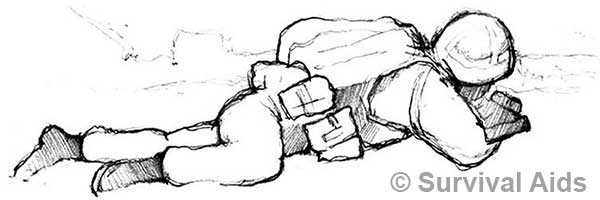
Monkey Run Hands and knees, behind low cover, you can move quite fast, but to do it quietly place your hands gently so as not to disturb things on the ground, i.e. twigs
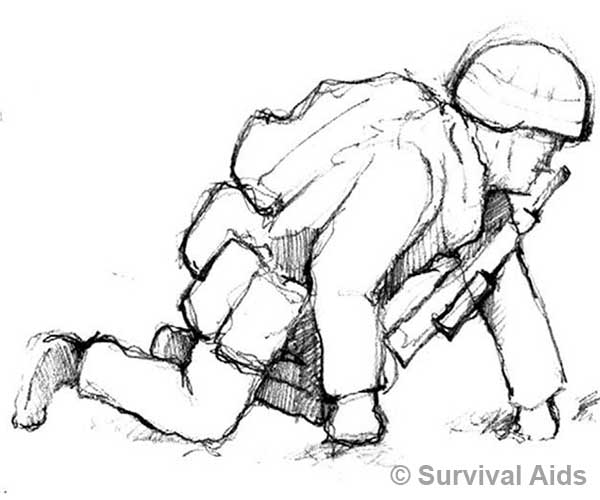
JUDGING DISTANCES
If you can accurately judge distances, quickly and under pressure, you can identify the area to look in when you receive an FCO, and to set your sights correctly in order to destroy the enemy. Here are a few methods to help you do that.
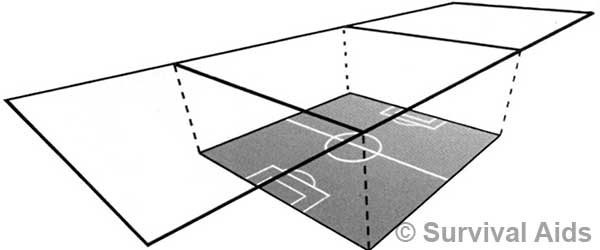
UNIT OF MEASURE
100 metres is a unit of measure that we are all familiar with ranges are laid out in 100m lengths, and a football pitch is approx. 100m long. So to estimate a distance imagine how many football pitches you can fit in between you and the target. This method should not be used over 400m if there is dead ground between you and the target, as you will not get an accurate reading.
THE APPEARANCE METHOD
Knowing what a normal sized man looks like at different ranges, will help you to judge distances. So the next time you’re on the range, for background activity, place 6 soldiers of normal height at 100m – 600m and observe them at each range from standing and prone, using optical sights, iron, naked eye and binoculars with graticule.
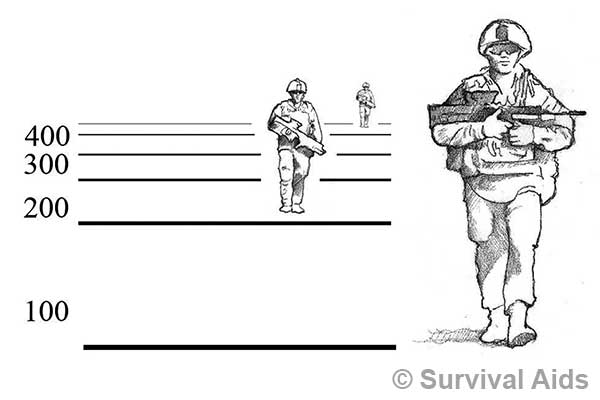
KEY RANGES
If you know the distance from your position to a building or feature near your target, use this to assist you. Accurately filling out a range card within 30 mins of occupying a position will assist you with this.
BRACKETING
If you’re having problems making an accurate guesstimate, estimate the furthest distance it could possibly be, then the shortest it could possibly be, it should be in the middle of these two.
HALVING
Estimate the distance halfway to the target and double it.
GROUP AVERAGE
If you can’t decide or don’t trust your own guess, then get the rest of the section/ptl to have a go and take the average
Laser Range Finding Binoculars You may well be lucky enough to have access to this equipment, make sure you have a fresh set of batteries when you deploy and get hands-on before you go out, know your kit.
MAPPING
Hopefully, you will have accurate mapping, so use this to work it out, the above methods can be used individually or in conjunction with each other.
Every time you try and judge distances it will be different light, time of the year, weather etc... So here are a few things that you need to bear in mind.
Things will seem closer When it's bright, if there’s dead ground between you and the target, if the object you’re looking at is higher than you and if it's significantly bigger than its surroundings.
Things will seem further away when the sun is in your eyes, in a bad light, when the object you're looking at is smaller than its surroundings.
RANGE CARDS
A range card should be filled out if you are occupying a position, for 30 mins. or more. You’ll soon realise how useful they are when you come under attack or need to call in fire. It might seem like a nuisance at the time, but by completing one you will naturally identify likely cover the enemy will use in the approach, work out the range to it. You can then issue a clear FCO and bring your weapons to bear accurately, including mortars and support weapons. Giving the enemy a bloody nose may discourage further probing patrols. Get your mate to check it as well as the section commander, it will be his or the Pl commanders’ responsibility to make sure it’s accurate.
(Tip Top Tip, buy a laminator and then with scotchbrite rub of the shiny sheen, this means you can write on it in a pencil with a rubber, and rub out and re-use time and time again. No need for permi pens and wipes, do the same with 9/10 liners, and all other forms in your notebook).
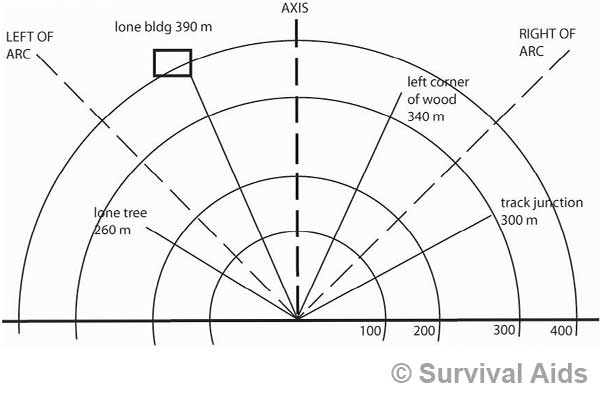
CLOCK RAY METHOD
Superimpose a 12-hour clock face, either vertically or horizontally on an object or on an area, to indicate the position of something. In a vehicle between the crew, take a line through the vehicle with the front of the bonnet as 12 and the rear as 6. "bloke with a motorbike approaching at 3 o'clock" or "12 o clock police checkpoint". The target might be close to an object that you've already identified to the section on your axis. Using the clock ray method will draw their eyes on to it quickly.
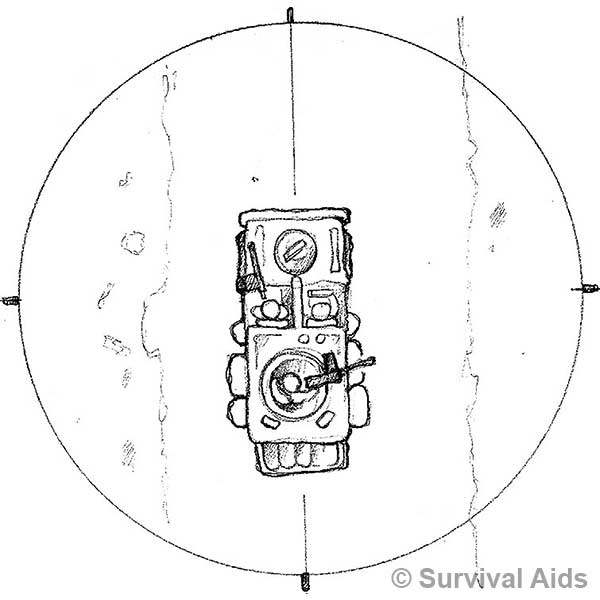
Fire Control Order, using Clock Ray method:
Section, 350, half left, brick building, 8 o'clock of house, enemy in a bush
In FOBs and sangars, many positions now have digital photographs in place of sketches. Panoramas which have been printed out on a colour printer and marked up with the axis named points and their ranges. The Ops room will have one similarly marked to refer to.
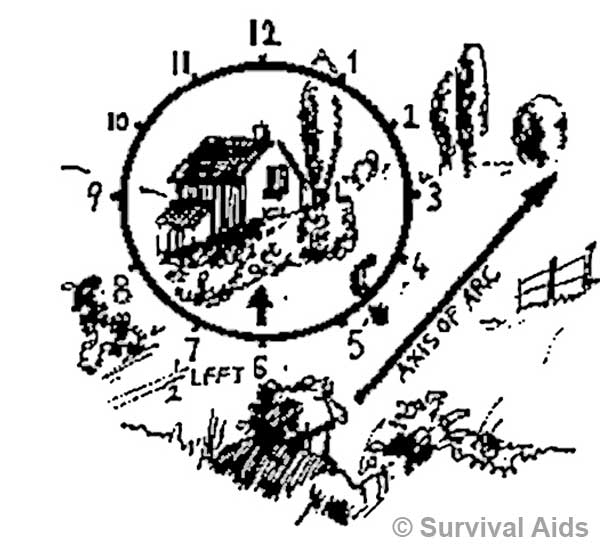
FIRE CONTROL ORDERS
When the section comes under effective enemy fire, the section commander will shout “take cover”. Effective enemy fire is defined as when rounds are falling at/near your feet and if you continue your present course, the section will take casualties.
The Immediate Action (IA) is RTR (Return fire, Take Cover, Return accurate Fire). The section is now in cover, and the enemy needs to be located and dealt with.
FIRE AND MANOEUVRE
The principle of fire and manoeuvre is no movement without covering fire. Charlie fire team laying down fire while Delta is up and moving forward in the assault.
A Co sized group crossing open ground may look exposed but the Coy Commander will have ordered his machine gun platoon to some high ground in overwatch.
A patrol moving through an area with AH cover overhead, which will not only cover them but also be able to report movement ahead, and to the flank. So fire and manoeuvre is a no-movement without covering fire.
Commanders should be familiar with all the weapons systems at their disposal so that they can use them to best effect and achieve the mission.
Once the enemy has been located, section commander/2ic will concentrate the firepower on the enemy using a Fire Control Order (FCO) using the mnemonic GRIT.
G = Group “Charlie Fire Team”
R = Range (in metres) “300”
I = Indication (where to look) “Half right, gap in wall”
T= Type of fire “Rapid Fire”
“Charlie Fire Team, 300, Half right, gap in wall, Rapid fire”
If you’re the only one that can see the target you’ll have to do it, so you’ll need to practice, don’t wait until you’re in contact.
TYPES OF FIRE CONTROL ORDER
You will receive or have to give, different types of FCO depending on the target and the time you have. FCOs are a useful thing to practice as background activity on the ranges
Brief Orders: You have little time, you have come upon the enemy and need to strike to maintain the initiative, or have been ambushed yourself, and need to quickly bring the section weapons to bear.
“Section - quarter right- rapid fire”
Full Orders: The section commander has time to assess the situation and deliver an FCO to destroy the enemy, using the position of his section and weapons (wpns) available.
“Gun group - 450 metres - left of axis - doorway - bursts”
Delayed: The section commander has intelligence that the enemy is going to appear at a certain location and issues a delayed FCO so that the section can open fire as soon as they appear.
“Delta Fire team - 200 - quarter right - small wood - when enemy appears - open fire”
Individual Orders: Issued to individual Riflemen, they might have a commanding view, or have a suitable weapon.
Remember....... when you’re issuing a Fire Control Order it is just that... an “ORDER”. The lads might be spread out, totally focussed on what they’re doing, shifting position, changing mags, maybe a little frightened. So take a breath, get their attention, inspire confidence and give it LARGE.
C = Clear L = Loud A = As an order P = With pauses
“Number 1 and 2 Riflemen - 100 - left of farm buildings - enemy in that area - watch and shoot”
RATES OF FIRE
Rapid Fire: 30 rounds a minute
Deliberate Fire: 10 rounds a minute
COVER FROM FIRE
If you can’t get into hardcover then lowering your profile should be your first action, drop down onto one knee, we all favour a particular knee so make sure it’s got a knee pad on, they’re superb bits of kit
SLICK MAG CHANGES
Practice, practice, practice. Ideal background activity that will pay dividends. Slick mag changes are the mark of a good infanteer, but it takes practice, the watchword is “Fast is Slow, Slow is Smooth and Smooth is Fast.”
COUNT YOUR ROUNDS
You should always count the rounds you’ve fired, know how many you have left in your mag, it gives the nervous blokes something to concentrate on, other than their fear. If you’ve got 4 rounds left and there’s a lull, put a fresh one on, you don’t want to be doing a mag change when your buddy’s in the open relying on you. Work in pairs and rebomb the expended mags with the loose you’ll probably be carrying. Anticipation at all levels, the first principle of the battle procedure.
If you’re under fire and have to change mags or have a stoppage, scream “magazine”, and keep yelling it till you’ve put another mag on. Get yourself into cover, but remember to keep your eye on the enemy, time can run away from you and by the time your back in the aim your enemy may have slipped away. Keep your head up, don’t look at your pouches, you know where they are. Practice, Practice.
Tactics can be loosely described as using everything at your disposal to achieve your mission from your knowledge of the enemy’s TTPs to your best rifleman who is a natural shot with the sharpshooter rifle. Get to know everything about the area you’re in, the assets you have availed to you and capabilities and bring it all to bear on the enemy and destroy him.
SENTRY DUTY
“Stagging on” or sentry duty in turns, will be arranged by the section commander. Usually, an hour on each, changing on the hour keep it simple, it ensures that the rest of the lads can get some rest, scoff, admin themselves, battle clean their weapons in relative security. So you need to approach it with as much care and attention as when crossing open ground near the enemy. It’s just as important, they are all relying on you.
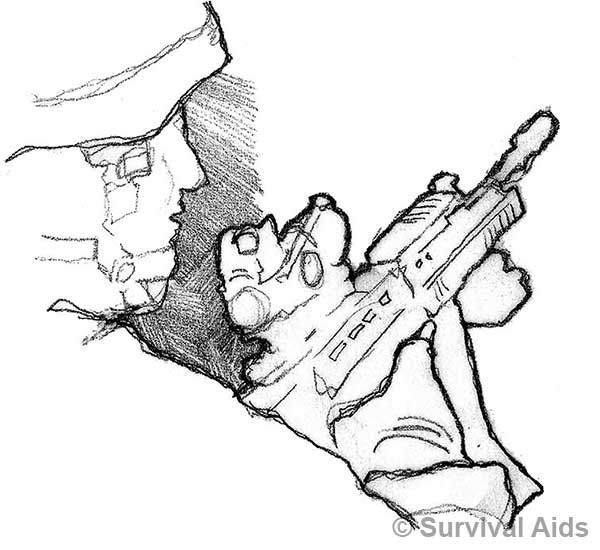
THINK IT THROUGH IN A LOGICAL ORDER
Know what time you’re on stag, make sure before you go to the stag position that all your kit is packed and ready to go, it might not be you who grabs it and carries it off when you bug out. If an attack comes from your direction you’ll be busy getting the rounds down while the others pull back with your kit, if your kit is all over the place it’ll get left behind, you’ll be busy buying them time aggressively defending. If you’re taking over the GPMG on stag and you hand your weapon over, where’s it gone, it’s zeroed to you after all? You’ll need to get it back, If the enemy’s pre-seen by you how do you alert the rest of the Platoon, comms cord (how many pulls?), radios, they seldom work when you need them to, what’s your no comms plan? So as you can see there are a lot of things to think about and things that need to happen for it all to run smoothly. After all it’s a thinking man’s game.
WHAT ARE THE ACTIONS ON IF YOUR POSITION IS APPROACHED?
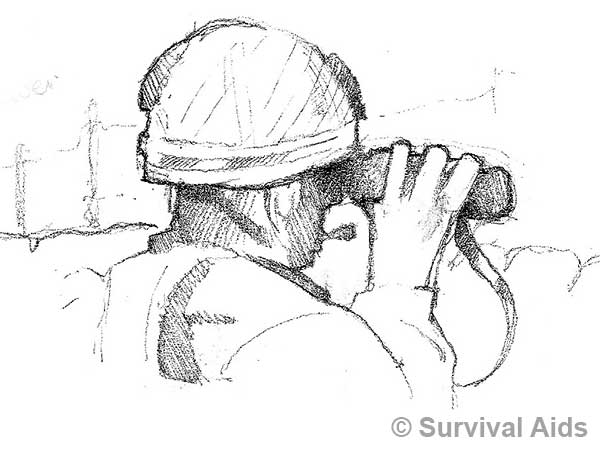
a. If you’re alerting by radio?
b. what’s the plan b if you get no comms?
c. if you are on alone, do you yank the comms cord? which is laid out to the pl commander’s basha
d. How will you alert the rest of the pl quietly?
e. If you’re on in pairs, you can send your oppo to alert the rest of the pl/sect while you keep eyes on the threat.
f. If you do get “bumped” then how long will you have to hold your position before the rest of the Sect./Plt are up and responding?
WHAT WILL THEY DO?
You need to know all this so that when the confusion of contact rolls over you, as it will, you know what your mates are going to do and where they’ll be.
KNOW THE CHALLENGE PROCEDURE.
Know what ground you’re supposed to watch, the direction of the enemy, but also what friendly pls will be passing through your area, and when.
Know the passwords, and if they are going to change, when?
It’s a lot to try and remember, but if you run through a likely scenario in your head. “What would I do if..?” then all the answers will fall out. And you can counter the boredom of stag by running through them a few times, a little mental rehearsal, it's better than clock watching.
SITUATION AWARENESS
Our minds wander when we drive to work, we’ve done the journey so many times, what’s the worst that could happen? Probably not that much, apart from a shunt or taking a wrong turn, most of us drive on autopilot anyway. We’re not always 100% aware of our surroundings, thinking about home, money, our social lives, any number of things.
But when you’re in a hostile environment you can’t afford to “switch off”. You need to be aware of where you are and what’s around you, is it a threat to you and your pl. And we’re not just talking about operational theatres here, it’s anywhere/anytime that you’re at risk.
Situation awareness is tuning in to your surroundings, and your preparation should begin long before you get to theatre. What would happen if we were contacted here! What if an enemy appeared there?
Know your enemy, know how he operates and know his environment. Knowing your personal strengths and weaknesses is part of your preparation as well, the environment is unforgiving, make your mistakes in training, learn from them, train, train, train and don’t make them in theatre.
YOUR SENSES
They’ll be on full alert when on stag, searching for the enemy or recceing an area, when you stop for a listening halt, drop to one knee lowering your profile. This allows you to see what’s around you from a different angle and this may mean the difference between missing something and spotting it, defeating the enemy’s camouflage, it's not going to be easy if he’s done a half-decent job, so that extra effort might make the difference. You then will possess the element of surprise. Dropping to one knee for long periods or regularly on a patrol can be tiring and painful, especially if you’re stiff and inflexible, so if its painful remember to pay more attention to stretching when you’re back in the gym, get it checked out, remember “prehab not rehab” see physical training chapter
SOUND
At night this is particularly important and if you want further confirmation then get down on your belt buckle. Poachers use these techniques. You can enhance your hearing by cupping your hands around your ears, this in effect channels the sound into them. Sound travels in waves just like light, electricity or water, your ears are shell like shapes for that very reason in order to channel the sound into the ear, so cupping your hands around them will mean you can hear more.
(top tip: if you have to talk at night because you have to pass a message, take a deep breath exhale over half of you breath and then whisper, talk calmly and slowly. This will prevent you from hissing, which can carry in the dark.)
Your senses work together as a system, but it’s a little like running 5 or 6 programmes on a computer, inevitably the performance will suffer if they’re all working. If you want to concentrate for a few seconds because you think you can hear movement ahead cup your ears with your hands, and close your eyes, meaning your hearing is enhanced a small amount of sound reaches the ear drum through your mouth, so you can open your mouth.
But remember to get your oppo to cover your arc for you, as you’ll effectively be blind with your weapon on the floor looking a bit of a prat lets be honest, but any advance warning of enemy movement ahead is worth it.
You can’t patrol at 100% alertness with your weapon in the aim indefinitely, you won’t last long, find a balance of preparedness and rhythm, the Lead Scout will be under a good deal of pressure as he will be coming up against the enemy first, so make sure you rotate the LS regularly.
NIGHT VISION
It takes your eyes about 30 mins to become accustomed to the dark, flashes of torchlight, internal lights in vehicles, car headlights and flares can all wreck your night vision capability. Try and shut your shooting eye if you’re surprised by a light so that you can use your weapon and let your other recover. The retina, the layer at the back of the eye, contains two types of receptors, rods and cones. The rods are more numerous and more sensitive than the cones, but they are not sensitive to colour, they kick in at night.
The cones see colour and are at their best during daylight.
The optic nerve connects to the eyeball at the back of the eye, and around this area is a blind spot. You won’t notice it during the day, but you do at night, a consequence of this is that if you stare directly at something at night, trying to pick out detail, you won't be able to see it very well. Try using a figure of 8 movements to scan the object or area, that way you’ll be using the rods around the blind spot.
Have you ever wondered why animals have better eyesight in the dark than we do? Nocturnal animals have an extra layer of cells at the back of the eye. Their day vision is not as good as ours, they are effectively colour blind but they make up for it by having good night vision, which is why we get the photographic “red-eye” and animals tend to look green and yellow.
Snakes have two sets of eyes, one set is the normal eyes that you see, that detect colour quite well. But they also have vision pits that detect heat and “see” living creatures like an infrared detector. Dragonflies have such quick eyes and brain that they see the world in slow motion compared to us.
IN DENSE WOODS
Moving through dense trees or wood blocks at night, its easy to lose the fella in front of you and the section can get separated. Compasses give off a very faint light, drape your compass over your shoulder so the guy behind you can follow it. Patrolling through woodblocks at night can be a very noisy business, heavily laden, tired soldiers, breaking branches and the noise of them whipping back as you pass by.
One way to cut down on the noise is to remove your side pouches and stowing them in your bergen. Some bergen's have a side pouch zipped on the top flap so you can temporarily attach it to the
You could choose to tailor your bergen so that the side pouches are situated permanently at the rear, your bergen will then be no wider than your shoulders allowing you to pass more quietly through the woods, making a lot less noise.
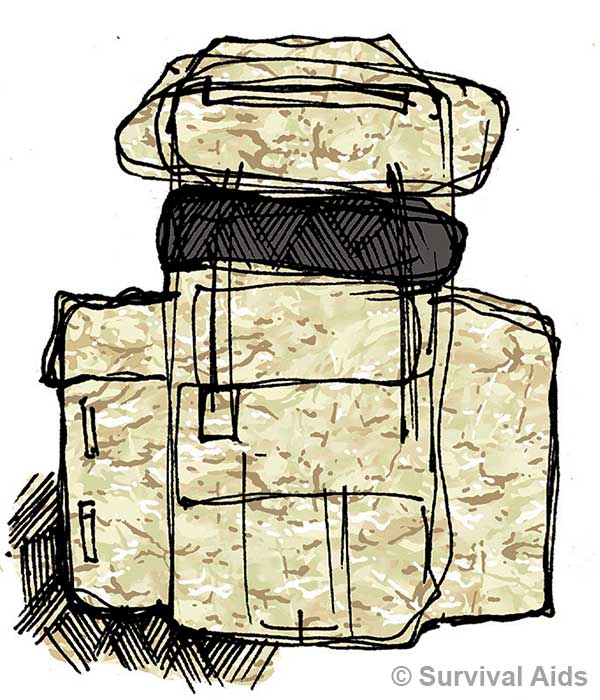
FASHION IN THE FIELD
We pick up much more information than we can consciously process, our brain filters out an enormous amount. If we were aware of everything around us we would literally stop in our tracks, sensory overload. Identifying our colleagues by their kit, equipment. will help sentries, and you’ll be able to recognise individuals by their hat styles etc...
SMELL
You’d be amazed at how far smell can carry and in the field. Aftershave/toothpaste can give you away you don’t need to be an experienced tracker to be able to distinguish between straight cigarettes and roll-ups. The longer you spend outside the more tuned in you’ll be.
We can train our senses in the same way we train our bodies and minds, whilst at school, our brains were challenged all the time with lessons, and homework, as adults we get out of the habit, we lose that wonder of learning. The Ninja clans of ancient Japan over 1000 years ago used to train a different sense each day.
They would wake each morning and before opening their eyes a trainee would concentrate on one sense, hearing for example. He would lie still for twenty minutes and concentrate on sound, try to reach beyond the normal sound of the household, beyond the normal boundary of his senses to detect sounds outside the house, in the street, harnessing his senses to work for him, training his hearing to be a tool to alert him of danger. Our senses have fallen out of use.
PATROLLING
Patrols companies throughout the army select the best men, patient, diligent, resourceful, determined, and there are few who do it as well as the Pathfinders.
“In warfare patrolling is the basis of success, it not only provides eyes to the side that excels at it, and blinds its opponents but through it, the soldier learns to move confidently in the element in which he works”
This quote, on display at their base, is one which the UK Pathfinder Platoon adhere to in their task as 16 Air Assault brigade’s patrol formation, it sums up what patrolling is all about.
AIMS OF PATROLLING
Obtain information: Knowledge is power and can be the key to success, this is sometimes gained by daring to get close to the enemy, its the same in any walk of life from business to entertainment, knowing what the opposition is up to, gives you the edge.
Dominate the ground: Denying the enemy freedom of movement, preventing him from mounting patrols against you, own the ground in front of your position.
Destroy and Disrupt: Fighting patrols can create havoc and fear far beyond their size, but this requires a disciplined team and a strong patrol commander
The Principles
Mutual Support - All Round Defence - Deception - Comms
TYPES OF PATROLS:
Patrols broadly fall into three types, Recce - Standing - Fighting.
Recce Platoon up to ten days, or a shorter single night duration. Usually made up of a PC (ptl commander) and 3-5 soldiers depending on the task. They are not designed to be an offensive force, their tactics will bring their weapons systems to bear rapidly if surprised so they can extract quickly, they won't carry sufficient ammo for prolonged fire fights.
They can operate independently with little support but if they took a casualty that would effectively be them out of the game, it would take at least two to take the cas back. Ideally they would have a trained medic who would be able to treat the wounded if they need prolonged care.
Recce patrols rely on stealth as their main defence, sometimes removing cumbersome body armour , helmets and webbing, often travelling light and with specialist radio equipment, to enable them to get as close to the enemy as possible. Patrolling requires a very high standard of physical fitness and discipline.
Standing Patrol will move into a position and remain static observing the enemy movement from a concealed, fixed position and report on any enemy movement. They are essentially a static recce ptl, have the same capabilities but also the same restrictions. They can fight their way out if compromised but don’t carry the ammo for prolonged action.
Fighting Patrol unlike the recce and standing ptls the fighting ptl will be significantly beefed up in terms of men and weapons to enable them to carry out the task, which might be an ambush, an attack or to create a diversion. Other tasks might include catching an IED party red handed planting a device, protecting a recce ptls route back in (see principles - mutual support), covering a particular area when a mission is going elsewhere in the AO.
SEQUENCE
The first phase will be the receipt of the Warning Order, the acronym for this is SMTOCA, all the ptl will read it, and then sign it (A: Acknowledgement) and it will be returned to the Ptl Commander
S Situation
M Mission (probable mission)
T Time line to H hr
O O Group, including RV and timings
C Combat Service Support incl any changes in SOPs
A Acknowledgements
Orders: At the allotted time the whole patrol will attend orders, the PC will have done his mission analysis and time appreciation. Once you have received your orders it will be time for an inspection to ensure you have all the right kit, followed by noisy rehearsals where you can talk through things that you’re unsure about.
Enforced Rest, final prep the patrol will carry out a silent rehearsal, (at night if the patrol is at night) final checks of kit will be carried out. Then the patrol will deploy on the mission/task. Upon return to base the patrol will be thoroughly debriefed and a patrol report will be completed, while the information is still fresh in everyone’s mind.
BATTLE PROCEDURE
To send men into battle takes careful planning to maximise the chance of success and to protect them as best as you can. This begins with Battle Procedure, and the aim is “to ensure that he is sent into battle with a minimum of wasted time and fuss, knowing exactly what he has to do, how he’s going to do it, and what fire support he has to help him achieve it”.
The principles are:
1. Anticipation at all levels: the guys have a good idea of what they have to do, their kit’s prepped, they are well rested and ready to go
2. Efficient drills: practice, practice
3. Concurrent activity
4. Knowledge of the grouping system
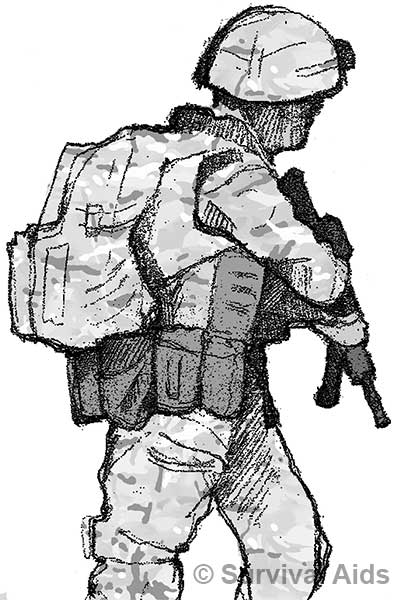
THE ASSAULT
1. Surprise
2. Maintain security
3. Seize key terrain
4. Achieve fire superiority
5. Manoeuvre your forces to max effect
6. Concentrate your combat power
7. Keep it simple
Plan rarely survive contact with the enemy, so it’s vital that you keep it simple, everyone understands their part and the commanders main effort, this will enable jnr commanders to use there initiative, if things start to go wrong.
SECTION BATTLE DRILLS
Section Battle Drills are a series of set piece moves on the battlefield that seek to ensure a successful action by concentrating a force.
No 1 - BATTLE PREPARATION.
No 2 - REACTION TO EFFECTIVE FIRE - RTR
No 3 - LOCATION OF THE ENEMY
No 4 - SUPPRESSING THE ENEMY
No 5 - THE ATTACK
No 6 - REORGANISATION
Everything in the Army is riddled with mnemonics and abbreviations to make it easier for you to remember what to do and in what order. When you think of the assault remember PAWPERSO - RTR - PACESSDO and you won’t go far wrong.
SECTION BATTLE DRILL NO 1 - BATTLE PREPARATION
Protection: make sure when you’re planning and preparing for the next phase that you are in a secure location, sentries out.
Ammunition: ensure all weapons systems are scaled, spare ammo bombed up and in sandbags.
Weapons: battle cleaned, sight sights zeroed and in your day sack, you don’t know how long the assault may take
Personal Cam: buddy buddy check each other
Eqpt: checked, tested and secured
Radios: comms checks carried out
Specialist Eqpt: ladders, hooligan bars
Orders: know when/where the Orders are
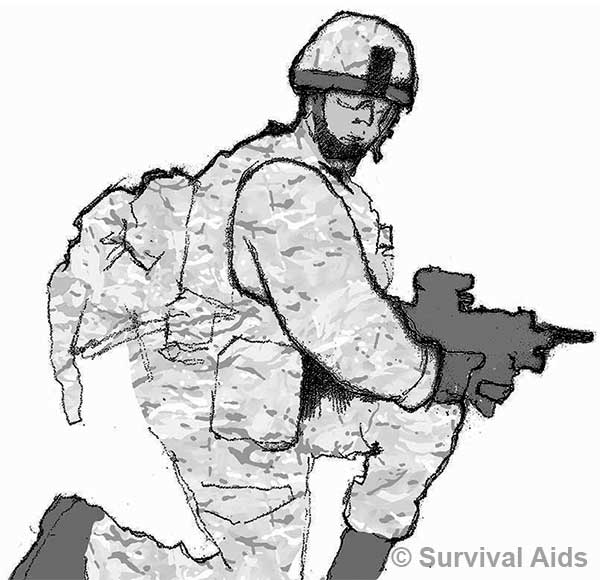
SECTION BATTLE DRILL NO 2 - REACTION TO EFFECTIVE FIRE - (RTR)
Return fire: if the enemy is right in front of you, get off a few rounds as quick as you can, looking over the Emergency Battle Sights (EBS). Getting an accurate aimed shot off using an optical sight can take a trained soldier between 3-4 seconds, which might mean the enemy gets the drop on you. Drop to one knee and get a few more off in the aim to keep his head down, your oppo behind you will see where you’re firing, aiding him in identify the enemy position.
Take cover: while patrolling think “if we get contacted here, where will I take cover?” it might mean dashing forward a few paces, or back behind a small bit of cover or into a fold in the ground. Keep your eyes on the enemy and also on the blokes to your left and right, keep your head up and your senses alert. If there’s nowhere to go then it’s on your belt buckle as quick as you can.
Return appropriate fire: an initial weight of fire will go down as the section engages the target, keeping his head down, then you need to win the firefight. Listen out for the FCO and conserve your ammunition. If you’ve got 6 mags, with 28 rounds in each that’s 168 rounds and you do not want to run out. Make each round count, aimed shots only, with the weapon in the shoulder.
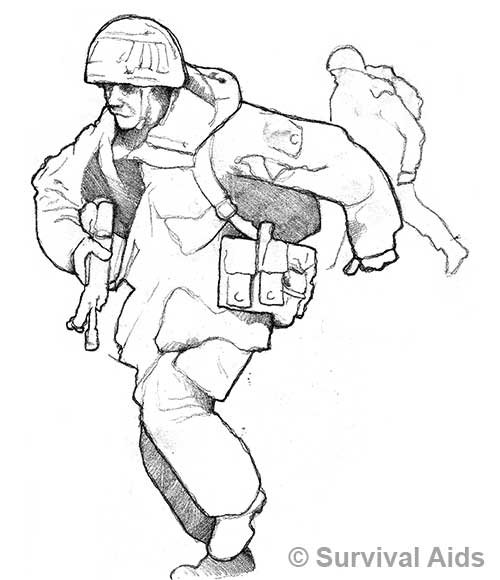
SECTION BATTLE DRILL NO 3 - LOCATING OF THE ENEMY
Locating of the enemy is never easy, even on exercise, when you add unfamiliar terrain, fear, noise, heat, confusion it can seem far harder. The initiative might be lost, momentum might stall and the longer you’re static the more likelihood of taking casualties. The advantages are the rest of the section looking and scanning, your drills and skills, and excellent optics of the SA80.
Observation: look where the rest of the section are shooting or pointing, look for likely cover, where would you hide if you were the firer, dust kicked up by the muzzle, smoke from oily barrels, movement, crouching dashing figures.
Fire: into likely cover and observe
Movement: look for the enemy movement, you might be able to get him to reveal his position by changing your position, if the enemy sees one of the section up and running, he may be emboldened to pop up and engage you. Meanwhile the rest of the section will have their eyes peeled engaged him or identified his position.
Crack and Thump: A very effective method in open ground, however the sound waves can bounce about in close country off walls giving you a false impression. When the high velocity round passes over your head ( hopefully) you will hear the crack before the thump, this crack is the sound of the round splitting the air above you, literally ripping through it, a few seconds later you will hear the thump, this is the sound of the rifle being fired, but because the round is travelling at more than the speed of sound it’ll get to you before it’s accompanying report.
We can use this knowledge to our advantage, when you hear the crack, pause if you can, and try and listen out for the thump, and hear where it came from. With practice you will also be able to detect how far away the firer is, from the delay in the thump, meaning that the sound wave has farther to go to reach you. This will come with practice.
A soldier was escorting a group of embedded journalists in Afghanistan when they came under fire from the enemy, they took cover and were chest deep in a ditch moving toward safety, one remarked that it was bad enough already without all the bloody hornets buzzing around over them!!!! - what hornets???
SECTION BATTLE DRILL NO 4 - SUPPRESSING THE ENEMY
When the enemy position is identified an FCO must be given to bring sufficient weight of fire on the enemy to neutralize them. The Section 2i/c takes control, to ensure that ammo is conserved, and the section uses its weapons and positioning to maximum effect.
FCO - GRIT - CLAP
SECTION BATTLE DRILL NO 5 - THE ATTACK
The Approach (QBOs) - Assault - Fight Through (momentum, maximum use of weapons, control, one foot on the ground) - Exploitation.
The Approach: including Quick Battle Orders (QBOs). The section is close to the enemy position after having had a quick final look, the commander drops back down and tells the section his plan. Depending on the amount of time he has will determine the extent of his QBOs. If he sees the enemy in disarray he may call for a hasty attack, or he may take a minute or two to give a detailed order.
Charlie in Fire Support with Delta in the Assault. Delta will move once the order has been given to open up and suppress the enemy position.
The Fight Through: when the assaulting section or half section closes with the enemy they often break down into pairs fire and manoeuvre, one soldier covering the other while he bounds forward, Movement by either fire team must be covered by fire from the other. As the assault is made the Fire Support Team should fire across the objective for as long as possible, then switch it’s fire across the objective onto enemy depth positions.
Exploitation: it’s important not to go too far, you may stray into another Sections arcs of fire, or move too far and encounter more positions and risk the overall momentum of the attack.
SECTION BATTLE DRILL NO 6 - THE REORG
When the objective is taken, the section commander must regain control of the men and be prepared to hold the position, ready to beat off a counter attack. The “REORG” is called, on or slightly beyond the objective depending on your Limit of exploitation (LOE). Fire support are called in, and it’s time to reassess the Platoon or Sections position after what could have been a pretty crazy 30 mins. There may be casualties to deal with and send to the RAP, dropped kit to find, ammo to dish out, mags to rebomb. A long list of things to consider.
The Reorg - (PACESSDO)
Protection
Ammunition
Casualties
Eqpt
Searchers
Sitrep
Digging
Orders





